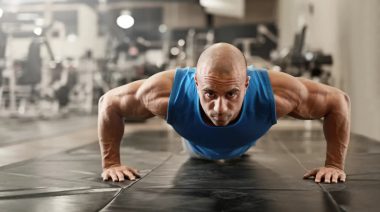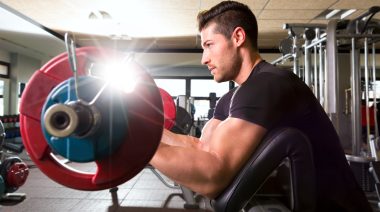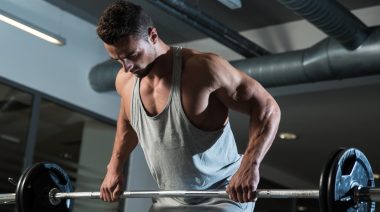Sometimes simple is better when it comes to exercise selection. And few exercises are as simple and equally effective as the standing dumbbell overhead press. You heave a couple of dumbbells to your shoulders, brace your core, and press them overhead.
The standing overhead dumbbell press requires your shoulders, arms, back, core, and legs to all work together to display a higher level of stability and strength compared to the more familiar barbell press. This specific press variation also adds muscle to the shoulders and creates an aesthetic physique.
Here’s a comprehensive guide to this comprehensive movement. Learn the technique and then add this old-school exercise to your program.
- How to Do the Overhead Dumbbell Press
- Overhead Dumbbell Press Mistakes to Avoid
- Benefits of the Overhead Dumbbell Press
- Muscles Worked by the Overhead Dumbbell Press
- Who Should Do the Overhead Dumbbell Press
- How to Program the Overhead Dumbbell Press
- Overhead Dumbbell Press Variations
- Overhead Dumbbell Press Alternatives
- Frequently Asked Questions
How to Do the Overhead Dumbbell Press
The overhead dumbbell press is an intricate series of moving parts — literally — because you’re taking two relatively unwieldy implements and getting them safely overhead under control.
The exercise does require a degree of coordination, but any lifter can master this movement with a little bit of practice and a few technique cues.
Step 1 — Get the Weights Into Position
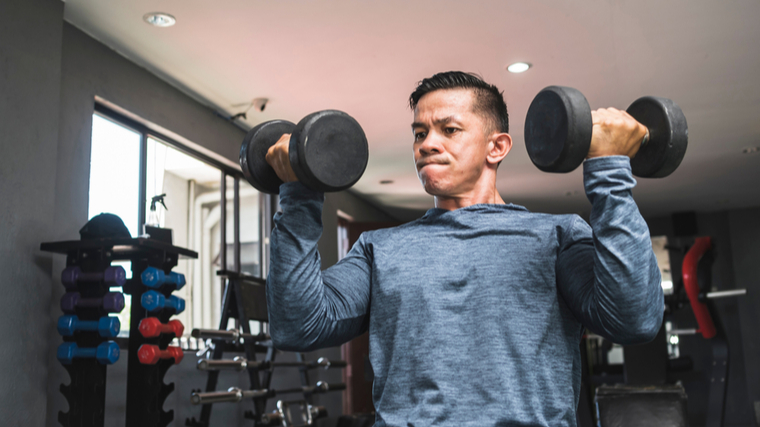
Begin with the dumbbells at your sides and your arms straight. You can either take the weights directly from the dumbbell rack, pick them up from a bench, or deadlift them from the floor.
Keep your back straight and abs tight. Bend your knees slightly before standing up powerfully while performing a thumbs-up curl (hammer curl) to bring the weights to shoulder level. Your feet shouldn’t necessarily leave the ground, but briefly rising onto your toes is common.
Stabilize your entire body when both weights are touching the front of your shoulders. Rotate each arm until your elbows are pointed to the sides and your hands are facing forward. Fortunately, you only need to go through this process once for each set you perform.
Form Tip: When using heavier weights, it may be less taxing and more efficient to begin with both dumbbells by your sides and raise one at a time into position, rather than trying to bring both to shoulder-level simultaneously.
Use the same “cheat curl” motion to bring each dumbbell up to shoulder level. However, the single-sided load will require more core stability to avoid rotating or swinging the body sideways.
Step 2 — Press Directly Overhead
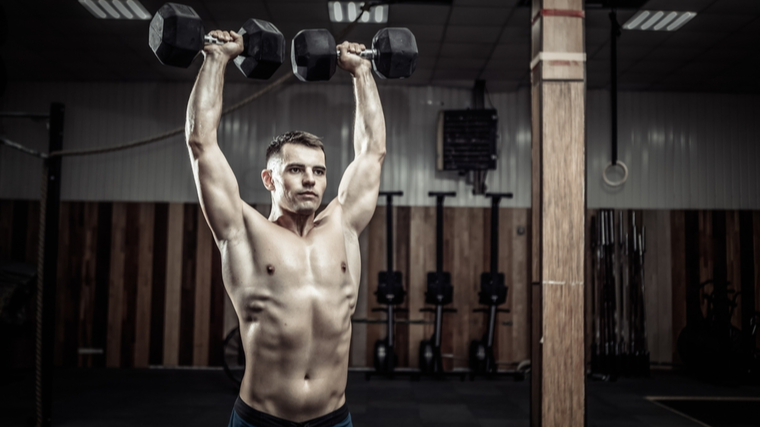
With your hands facing forward and your wrists in-line with the tops of your shoulders, press both dumbbells upwards while keeping your hands directly above your elbows. As the weights pass over your head, move them slightly towards each other. The weights should end up nearly touching at the top.
Your legs should remain slightly bent throughout the entire set. Keep a neutral spine and upright torso with your core fully engaged. Contracting the glutes prior to pressing also helps to “connect” your stable lower body to your upper body, ensuring a safe and powerful position. Don’t allow your upper body to shift backwards as you press upwards.
Form Tip: When some lifters fatigue throughout a set, they begin to start each rep with a quarter-squat motion to propel the weights up. This increases total-body muscle recruitment and allows heavier weights to be used and/or more reps to be performed, but it also reduces the amount of force produced by the shoulders specifically.
Step 3 — Lower Under Control
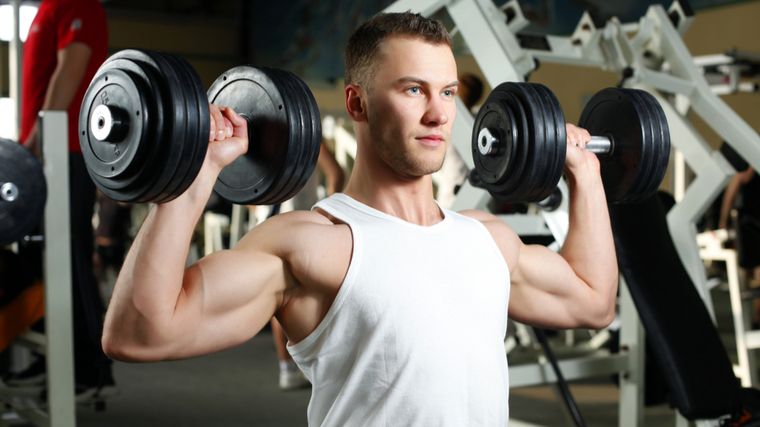
After briefly pausing the weights in a locked out overhead position, reverse the motion to bring the dumbbells down. Be sure your torso remains upright, not leaning back. Your wrists should end up in-line with the tops of your shoulders. This is the bottom position of a press. The weights do not return all the way down to hang at your sides until you’ve completed all reps and the set is over.
Throughout the descent, keep your elbows under your wrists. Allowing the wrists to drift in front of or behind the elbows will drastically increase stress on the support structures of the shoulder joint. Shifting the wrists to either side of the elbow will reduce muscular stress on the shoulder, making the exercise less effective.
Form Tip: If the bottom/stretched position is too extreme or painful, the most common solution (in addition to specific shoulder mobility work) is to use your ears, not the tops of your shoulders, as a reference point.
Performing each repetition from ear-level to full lockout avoids putting the shoulder joint in its furthest range of motion and should alleviate excessive joint stress.
Overhead Dumbbell Press Mistakes to Avoid
The overhead dumbbell press technique is essentially, “pick up weights, then press weights overhead.” However, there are a handful of common mistakes which can increase the risk of injury and decrease muscle recruitment. Here’s what to avoid.
Leaning the Torso Back
Maintain an upright upper body during the press. This not only reduces stress on the lower back, but allows more upper body muscles to provide support and stability. The recruitment of the core and upper back allow higher power output and a stronger lift. Keeping a vertical torso allows your upper back muscles to more efficiently control your scapulae, which are essential to pressing weights and avoiding injury.
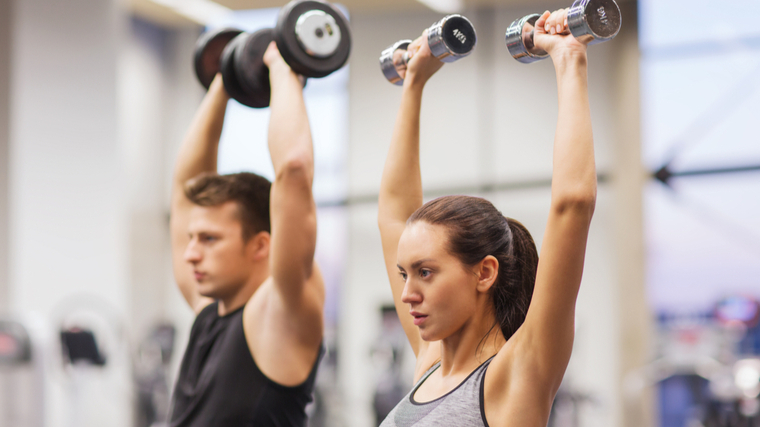
Leaning your torso backwards reduces your ability to maintain a strong core because strain is transferred more directly to the lower back. If you wanted to break a toothpick, you’d bend it until it snapped because it can withstand more stress when kept straight. Imagine your abs and lower back as one big toothpick. Don’t snap it.
Leaning back also changes the pressing angle, changing the lift from an overhead press into a high-angle incline bench press minus the bench. This transforms a very good shoulder exercise into a very bad chest exercise.
Avoid it: Before beginning any overhead press, check your ab and lower back stability and engagement by flexing your glutes and abs at the same time. If you feel an awkward and uncomfortable pull in the lower back area, it means you’re likely out of alignment. Adjust your posture and flex again before beginning your set.
Pressing With the Legs
As explained earlier in step two of the technique guide, your legs should remain slightly bent during a set of overhead presses. This allows your shoulders to be the primary movers of the weights and ensures your shoulders receive the greatest stimulus.
When any lifter nears the end of a challenging set, it’s important to remain strict and perform every rep from the same position. This rule applies to all exercises, with very few exceptions.
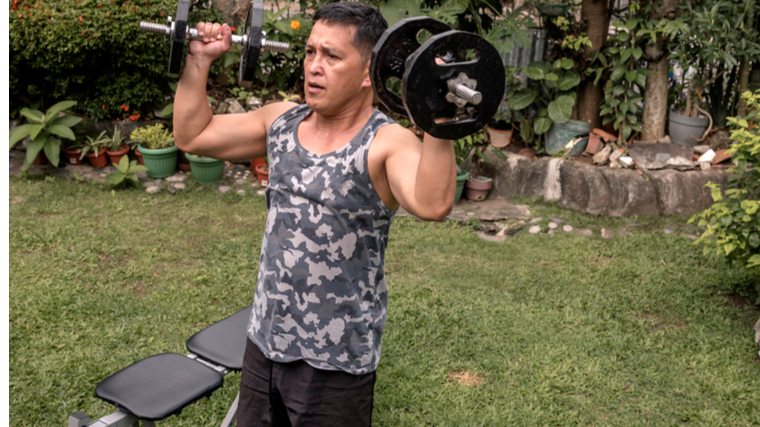
Adding leg drive towards the end of the set changes the exercise from a strict overhead dumbbell press to an overhead dumbbell push press. Different exercises are used for different purposes and target different muscles. In this case, the added work performed by the legs is counterbalanced by less work performed by the shoulders.
Avoid it: Use body awareness, especially towards the end of each set. As you notice your shoulders fatiguing, end the set knowing that your shoulders have been sufficiently trained with the intended load (weight) and volume (reps).
Using leg drive to complete a few additional reps is a high-intensity technique that should only be performed by experienced lifters, and should only be performed deliberately. Many lifters develop the bad habit of using leg drive without even being aware of it. This leads to a less efficient shoulder workout.
Short Range of Motion
The overhead dumbbell press should move the weights from shoulder-height to full overhead lockout. Reducing the range of motion either by not bringing the weights low or by avoiding complete lockout reduces the shoulders’ time under tension and reinforces poor joint mobility. This combination decreases the stimulus to build muscle and strength.
If you have pre-existing mobility issues, this is an entirely different case. You should never force your body into unnatural and dangerous positions. However, the shoulder joint, when healthy and working optimally, should be capable of achieving a complete range of motion.
Avoid it: Ensure that you take each rep from full stretch to full lockout. The dumbbells may graze the top of your shoulders in the bottom position and your elbows should be fully extended with the dumbbells nearly touching at the top. Know that short-changing your range of motion is simply short-changing your results.
If you’re physically unable to achieve a full range of motion, make consistent mobility work a regular part of your training. In the video above, Coach Geo Rockwell explains how to perform scapular wall slides, one of the best bang-for-your-buck shoulder and upper back mobility drills.
Benefits of the Overhead Dumbbell Press
Pressing a pair of dumbbells overhead isn’t just an old school test of strength, dating back to strongmen in the late-1800s. It’s also a classic exercise for building a wider set of shoulders. The combination of potential size and strength make it an incredibly useful exercise for nearly any lifter.
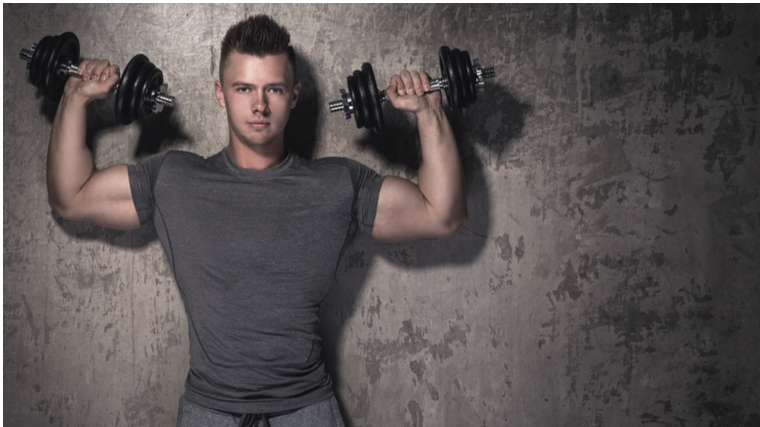
Because each arm is supporting an individual dumbbell, as opposed to one single barbell supported with both arms, you need more power output from each side of the body. More muscles are also activated both as stabilizers and for support strength.
Similarly, while any type of overhead press can be used for hypertrophy (building muscle), dumbbells require more work from each individual shoulder. This creates a higher overall training stimulus compared to other shoulder press variations.
Shoulder Size
Shoulder presses are practically mandatory for building a pair of wide, round deltoids (shoulders). The overhead dumbbell press can be highly effective, first because stabilizing the weights throughout each set will recruit the upper back and trapezius muscles, and also because the exercise has been shown to activate more deltoid muscle than other press variations. (1)
Upper Body Strength
The bench press is arguably the most popular measure of strength in most gyms. However, an unspoken rule among many experienced lifters is to gauge upper body strength by putting weight overhead while standing, not while lying supported on a flat bench.
The overhead dumbbell press, though not necessarily associated with moving extremely heavy weights, can play a huge role in building impressive overhead strength.
Reduced Joint Stress
The overhead dumbbell press requires each arm to perform its own share of muscular work while also having a degree of joint “freedom” to move, rotate, and micro-adjust throughout the range of motion. This freedom makes it a more joint-friendly option for lifters who may not be able to hold a barbell with a pronated (palms down) grip and press it overhead due to shoulder, elbow, or wrist mobility problems.
Muscles Worked by the Overhead Dumbbell Press
The overhead dumbbell press is a shoulder exercise, though a number of upper body muscles play a significant role to stabilize the body and complete the exercise.

Deltoids
The deltoids (shoulders) are technically one muscle group consisting of three heads — the anterior (front), the lateral (side), and the posterior (rear). The overhead dumbbell press significantly recruits all three heads and is a comprehensive shoulder exercise.
Triceps
Any type of pressing exercise will recruit the triceps muscle, specifically in the latter range of motion to achieve a complete lockout position. The overhead dumbbell press significantly activates your triceps when the weight is lifted from forehead-level to full lockout.
Upper Back
The “upper back” isn’t one specific muscle. Instead, it’s a general term typically including the rhomboids, trapezius, teres, and rear deltoids. These muscles play similar and overlapping roles in scapular movement and stability.
The overhead dumbbell press works your upper back statically in the bottom position as the weights are supported, as well as working more actively to help provide a stable torso position for pressing.
Who Should Do the Overhead Dumbbell Press
You can use the overhead dumbbell press to achieve a number of common goals. The exercise can, and should, be performed by a variety of lifters.
Lifting for Muscle
Due to its effective role as a fundamental muscle-builder, the overhead dumbbell press can be a priority exercise in a shoulder-building workout. The large time under tension and significant recruitment of the deltoids make it an efficient option.
Lifters With Joint Pain
Because dumbbells require less fixed-pattern movement and allows lifters to adjust hand and elbow position during a set, the overhead dumbbell press can be a better choice for lifters with current joint pain, compared to a barbell press.
Overhead Strength Athletes
A number of sports require lifters to move very heavy weights overhead. Competitive strongmen and strongwomen, Olympic weightlifters, and CrossFit athletes can all benefit from making the overhead dumbbell press a recurring accessory exercise in their training to carryover to sport-specific strength.
How to Program the Overhead Dumbbell Press
The overhead dumbbell press can be adapted to a variety of programming methods, depending on the lifter’s specific goal.
Moderate Weight, Moderate Repetition
Working within a prototypical bodybuilding set and rep scheme delivers optimal muscle gains. Performing three to four sets of 8 to 12 reps turns the exercise into a serious shoulder-builder. When the presses are kept strict and leg drive is avoided, this can be an intense delt workout.
Light-to-Moderate Weight, High Repetition
Reducing the weight slightly while increasing the reps to 15 or even 20 can provide more challenge to the entire body because the overall stability demands are increased, but the shoulder-focus remains a priority. Many lifters find they may get a better muscular workout with this approach, since shoulder joint stress is further reduced due to the decreased load.
Heavy Weight, Low Repetition
When using heavier weights for lower repetitions, the movement becomes an exercise in total-body coordination. When performing three to five sets of three to five reps, lacking muscular engagement anywhere from head to toe can result in a missed lift. This full-body support is exactly what makes this approach ideal for building strength.
Remember though, as weights get heavier, getting the dumbbells into starting position becomes a much more fatiguing part of the exercise, so expect the hard work to begin before you even start pressing.
Overhead Dumbbell Press Variations
The overhead dumbbell press is a straightforward movement suitable for most lifters and most goals. However, adjustments and variations may be appropriate for any number of reasons. By adjusting hand position or stance, you can fine-tune the exercise to your specific requirements without significantly changing the results.
Neutral-Grip Overhead Press
Adjusting the arm angle in the bottom position can drastically change the stress applied to the shoulder joint.
If you experience joint pain during any chest or shoulder pressing exercises, using a neutral grip, where the hands face each other during movement rather than facing forward, is a simple and effective way to alter the arm angle and reduce joint strain.
Seated Overhead Dumbbell Press
Some lifters may lack the core strength, either due to inexperience or previous injury, to fully stabilize during the overhead dumbbell press. Moving from a standing position to seated can reduce strain on the lower back, which reduces the required core stability element.
An important cue with a seated overhead press is to avoid leaning back excessively during the movement, which would return the low back stress meant to be avoided in the first place. If your hips/tailbone aren’t near the back-support pad, then your back isn’t actually supported.
Single-Arm Overhead Press
The overhead press is typically done with both arms simultaneously, but using one arm at a time offers a few specific advantages. First, it allows a slightly heavier weight to be used. For example, if you can press two 50-pound dumbbells for five reps, you’re likely able to press one 55-pounder for five reps. This has to do with muscle fiber recruitment, the central nervous system, and a handful of dull technical jargon.
The second major benefit of pressing one dumbbell is an even greater core stability challenge, which turns the exercise into an efficient way to train the abs, obliques, and entire core while still requiring shoulder power.
Dumbbell Push Press
Remember all those warnings about keeping your knees slightly bent for the entire set and not using leg drive? Well now here’s your chance. The dumbbell push press uses deliberate leg drive to start moving the weight on each rep.
This added lower body recruitment allows a heavier weight to be used and it’s also an excellent way to develop explosive power and speed, making the exercise a top choice for athletes in any sport.
Overhead Dumbbell Press Alternatives
The overhead dumbbell press does cover a lot of muscular ground, but there are a few similar overhead exercises which can offer comparable, sometimes even more effective, benefits.
Overhead Barbell Press
One limiting factor of the overhead dumbbell press is the actual dumbbell. While there are many well-equipped gyms, there are few gyms offering dumbbells over 100 pounds. If your goal is to build major pressing strength, loading a barbell will eventually become necessary.
The overhead barbell press, often referred to simply as “the press”, is also sometimes considered one of the most fundamental of all exercises, alongside the barbell back squat, barbell flat bench press, and conventional deadlift.
Landmine Press
The landmine press is an effective alternative to direct overhead pressing, especially for lifters with shoulder joint pain. The altered angle of resistance affects the load on the joint while incorporating more muscles, particularly the chest.
Many gyms now have landmine stations with a barbell set in a specialized stand. The exercise can also be performed by carefully wedging one end of a barbell into the corner of a room.
Kettlebell Press
The kettlebell press may appear identical to the overhead dumbbell press, but the kettlebell’s unique shape and offset center of gravity make it a different exercise with different technique requirements.
The range of motion is typically longer, as the kettlebell press often starts with the weight in front of the chest in the bottom position. Because the kettlebell sits behind the wrist while the dumbbell sits atop the wrist, the shoulder stabilizers will be under increased stress during the movement as the kettlebell tries to “pull” the arm into external rotation.
Start the Presses
The overhead dumbbell press is a thorough exercise which builds shoulder size and upper body strength with minimal equipment. No benches needed, no barbell and rack setup, just a pair of dumbbells and a place to stand. Review the technique pointers and fit this overlooked lift into your program.
FAQs
What if getting the weights into position makes me too fatigued to press?
Usually, getting fatigued during an exercise is a good thing. But in this case, you’re getting fatigued before the exercise, not during it. If getting the dumbbells into the bottom position is too challenging, it’s because you’re attempting a weight that’s beyond what your upper back can support.
Lighten the load to a weight you can successfully get into a pressing position, continue regular shoulder and back training, and progress accordingly.
When should I perform the overhead dumbbell press?
Because it’s primarily a shoulder exercise with involvement of other muscles, it’s best suited to a shoulder-focused or “upper body” workout. Performing it as one of the first exercises of the workout will allow you to apply the most focus and use relatively heavier weights than if performed later.
For strength-focused lifters, it’s best not to perform the overhead dumbbell press immediately after heavy squats or deadlifts, due to cumulative fatigue in the lower back and legs, which would impair those muscles’ ability to provide a safe base of support.
References
- Saeterbakken AH, Fimland MS. Effects of body position and loading modality on muscle activity and strength in shoulder presses. J Strength Cond Res. 2013 Jul;27(7):1824-31. doi: 10.1519/JSC.0b013e318276b873. PMID: 23096062.
Featured Image: Vladimir Sukhachev / Shutterstock


